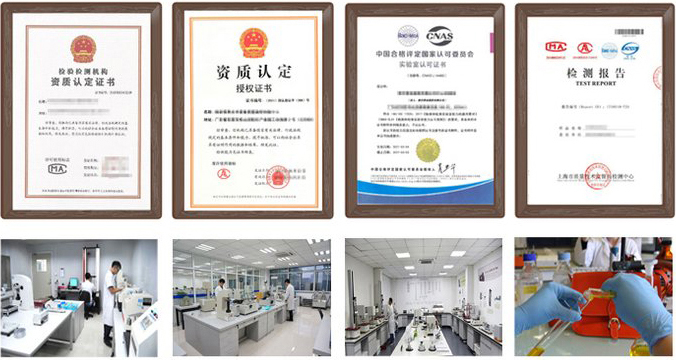Traditional Chinese Medicine Bioactivity DetectionHow to apply for a report? What items need to be tested? We will conduct testing and evaluation in strict accordance with the standards. We can also provide personalized testing plans and reports according to your needs.
The detection of biological activity in traditional Chinese medicine is an important part of evaluating the efficacy, quality control, and new drug development of traditional Chinese medicine. The following is a detailed introduction to the detection methods of biological activity in traditional Chinese medicine:
1. Basic principles of biological activity determination methods
Comply with the basic principles of pharmacological research: The established biological activity determination method should comply with the basic principles of randomization, control, and repetition of pharmacological research, and have the characteristics of simplicity and accuracy, at the same time, there should be clear judgment criteria.
Reflect the characteristics of traditional Chinese medicine: Encourage the application of biological activity determination methods to explore the quality control of traditional Chinese medicine, and the determination indicators of the proposed method should be related to the "function and indication" of traditional Chinese medicine.
Reasonable variety selection: The traditional Chinese medicine or traditional Chinese medicine preparations to be studied for biological activity determination should have clear functions and indications. Among them, priority should be given to varieties with clear indications, and traditional Chinese medicine injections and emergency and severe medicines should be studied in detail.
2. Classification and characteristics of biological assay methods
Biological potency determination method (quantity response method): Within a certain dosage range, the action trend is consistent, the dose-effect relationship is more obvious, and it is easier to quantify and evaluate. This method is preferred.
Bioactivity limit determination method (semi-quantitative method or qualitative reaction method): It is mostly used to evaluate the effect (such as agglutination, death, convulsion, etc.) only when a certain value (dose) is reached. It belongs to the semi-quantitative or qualitative category. When the bio-potency determination cannot be established, this method can be considered.
3. Basic content of TCM bioactivity determination
Experimental principle and observation index: There should be a clear experimental principle, which can reflect and explain the "function and indication" of the drug and reflect the main biological effect of the drug. At the same time, select the most sensitive observation index that can best reflect the function and indication of the drug.
Test drugs: Select TCM with definite efficacy, and relatively sufficient and clear research on the pathway and mechanism of action, such as TCM injection or drugs for critical illnesses. At the same time, it should be ensured that the source of the test drug is clear and the production process is determined.
Test system: Including whole animals, isolated organs and tissues, cells, subcellular organelles, receptors, ion channels, and enzymes. A system with clear background information, few influencing factors, low cost, and simple and easy operation should be selected.
Control setting: The experimental design should consider the use of reasonable blank and negative controls. If model animals are used, model controls and positive controls should generally be set up to illustrate the correctness of the operation and the effectiveness of the experiment.
Potency determination: A method of comparing the test substance with the standard control and controlling the quality of the test drug through biostatistical calculation. The selection of appropriate standard substances is the key to the experiment.
IV. Specific methods for determining the biological activity of traditional Chinese medicine
In vitro cell experiments: Different types of cell lines are used to evaluate the effects of traditional Chinese medicine on cell growth, proliferation, differentiation, and apoptosis.
In vivo animal experiments: Animal models are used to study the efficacy, toxicity, and mechanism of action of traditional Chinese medicine.
Anti-inflammatory activity determination: The anti-inflammatory effect of traditional Chinese medicine is evaluated by the determination of inflammation-related cytokines or inflammation models.
Antioxidant activity determination: The free radical scavenging ability and antioxidant ability of traditional Chinese medicine are determined using chemical reagents or cell experiments.
Antibacterial activity determination: The inhibitory effect of traditional Chinese medicine on bacterial growth is detected by the plate diffusion method or micro broth dilution method.
Antiviral activity determination: The inhibitory effect of traditional Chinese medicine on viral replication is evaluated using a virus and host cell co-culture system.
Immunomodulatory activity assay: Evaluate the immunomodulatory effect of traditional Chinese medicine by measuring the changes in immune cell activity and immune factors.
Antitumor activity assay: Evaluate through tumor cell proliferation inhibition experiment, tumor cell apoptosis experiment, and animal tumor model.
Neuroprotective activity assay: Evaluate the neuroprotective effect of traditional Chinese medicine using neural cell culture and related neurodegenerative disease models.
Enzyme inhibition activity assay: Determine the effect of traditional Chinese medicine on specific enzyme activity, such as acetylcholinesterase inhibition activity.
Receptor binding experiment: Evaluate the binding ability of traditional Chinese medicine components with receptors to understand their possible mechanisms of action.
Molecular docking technology: Use computational chemistry methods to predict the binding mode of traditional Chinese medicine components with target proteins.
V. Application of modern technology in the detection of biological activity of traditional Chinese medicine
High-performance liquid chromatography (HPLC): It is the main method for separating and analyzing active ingredients of traditional Chinese medicine (such as saponins) in recent years. It has the advantages of high separation efficiency, fast analysis speed, wide application range, good reproducibility, and stability.
Liquid chromatography-mass spectrometry (LC-MS): It combines the separation ability of liquid chromatography for high-boiling point compounds with the very strong identification ability of mass spectrometry, and is an effective means of separating and analyzing complex organic mixtures.
Near-infrared spectroscopy (NIR): It is a non-destructive, rapid, sensitive, accurate, and non-contact optical detection technology that can effectively and quickly perform quantitative analysis on the active ingredients in traditional Chinese medicine.
In summary, there are many methods for detecting the biological activity of traditional Chinese medicine, and the appropriate method should be selected according to the specific research purpose and experimental conditions. At the same time, with the continuous development of modern science and technology, new detection technologies and methods are constantly emerging, providing more choices and possibilities for the detection of biological activity in traditional Chinese medicine.
Test report function
1、Project bidding: issue authoritative third-party CMA/CNAS qualification report;
2、E-commerce platform entry: quality inspection reports recognized by major e-commerce platforms;
3、Used as sales report: issuing a test report with legal effect to make consumers feel more at ease;
4、Papers and scientific research: providing professional and personalized testing needs;
5、Judicial services: providing scientific, fair and accurate testing data;
6、Industrial problem diagnosis: verifying the troubleshooting and correction of problems in industrial production;


 National free customer service telephone 400-101-7153
National free customer service telephone 400-101-7153 

